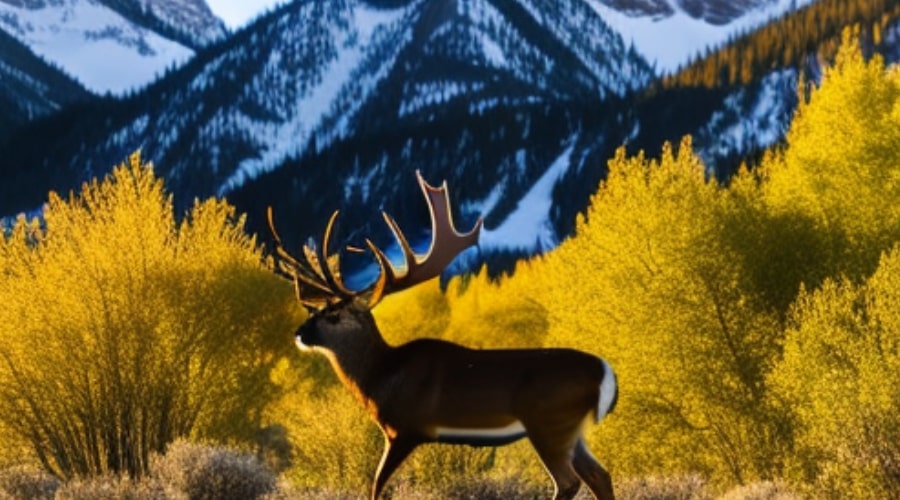Mule deer are one of the most common species of deer found in North America, known for their distinctive antlers and large, mule-like ears. But just how big are these magnificent creatures? In this article, we’ll take a closer look at the size and weight of mule deer and explore some of the factors that contribute to their size.
The Average Size of a Mule Deer
Mule deer are relatively large animals, with an average weight of between 120 and 220 pounds for adult males, and 80 to 130 pounds for adult females. However, size can vary greatly depending on a number of factors, including geographic location, diet, and overall health.
In terms of height, mule deer typically stand between 3 and 4 feet at the shoulder and can measure up to 6 feet in length from head to tail. This makes them one of the larger species of deer found in North America, although they are still smaller than their close relatives, the elk, and moose.
Factors That Affect the Size of a Mule Deer
There are a number of factors that can influence the size of a mule deer, including genetics, diet, and overall health. For example, mule deer living in areas with abundant food sources are often larger and healthier than those living in areas with limited food sources. Similarly, genetics play a role in determining the size of a mule deer, with larger individuals often passing on their genes to future generations.
Another factor that can impact the size of a mule deer is the presence of predators. In areas where predators are abundant, mule deer may be smaller and lighter due to the need to evade capture. Conversely, in areas where predators are scarce, mule deer may grow to be larger and heavier, as they do not face the same threat of predation.
The Antlers of a Mule Deer
In addition to their size and weight, mule deer are also known for their distinctive antlers, which can be quite large and impressive. The size and shape of a mule deer’s antlers are largely determined by genetics, although other factors such as diet, age, and overall health can also play a role.
Mule deer antlers typically begin to grow in the spring and can reach their full size by late summer. They are made of bone and covered in a soft, velvet-like material that is rich in blood vessels and provides nutrients to the growing antlers.
Once the antlers have fully grown, the velvet dries up and falls off, leaving the deer with their hard, polished antlers. These antlers are used for a number of purposes, including attracting mates, defending territory, and fighting off predators.

Size and Weight of Mule Deer
Mule deer are medium-sized deer, with a body length of 5-6 feet and a shoulder height of 3-4 feet. The weight of mule deer can vary greatly depending on their age, sex, and location. Adult male mule deer, known as bucks, can weigh anywhere from 120 to over 300 pounds, while adult female mule deer, known as does, typically weigh between 80 and 200 pounds.
Physical Characteristics of Mule Deer
In addition to their large ears, mule deer are known for their distinctive antlers, which are used for self-defense and attracting mates. The antlers of mule deer are large and complex, with multiple points branching off in different directions. The size and shape of mule deer antlers can vary greatly from one individual to another.
Another unique feature of mule deer is their distinctive black-tipped tails, which they use to signal to other mule deer. When a mule deer is alarmed, it will raise its tail and expose the black tip, serving as a warning signal to other mule deer in the area.
Mule deer also have large hooves that are well-adapted to the rough terrain of their native habitat. These hooves are wide and sturdy, providing mule deer with excellent balance and stability while they are running or jumping over obstacles.
FAQ:
What is the average weight of a mule deer?
The average weight of an adult male mule deer is around 200 pounds, while the average weight of an adult female mule deer is around 120 pounds.
What is the average body length of a mule deer?
The average body length of a mule deer is around 5-6 feet.
What is the primary food source of mule deer?
Mule deer are herbivores and feed on a variety of plants, including grasses, shrubs, and leaves.
Where can mule deer be found in the United States?
Mule deer can be found in many parts of the western United States, including states such as California, Colorado, Idaho, Montana, Nevada, Oregon, Utah, Washington, and Wyoming. They have also been introduced to other parts of the country, including states like Kansas, Nebraska, and South Dakota. Mule deer are adaptable and can be found in a variety of habitats, including deserts, forests, and mountainous areas.
Conclusion
Mule deer are large and impressive creatures, known for their distinctive antlers and large, mule-like ears. The size of a mule deer can vary greatly depending on a number of factors, including genetics, diet, and overall health, as well as the presence of predators. Whether you’re a wildlife enthusiast or just a curious observer, the mule deer is an animal that is sure to impress.





Leave a Reply